Chesterfield Corporation Tramways
History
Chesterfield Corporation became a tramway owner and operator on the 22nd November 1897, seemingly without parliamentary sanction, when it took over the standard-gauge, horse-drawn tramway of the Chesterfield Tramways Company. The horse tramway was just 1.25 miles long, running from a terminus at Low Pavement on the Market Place, westwards along West Bars, then southwestwards along Chatsworth Rd to the western terminus at Brampton, just short of Walton Lane.
The corporation immediately set about putting its new acquisition in order, and halving ticket prices, a move which saw passenger numbers rise, the tramway prospering for what was very probably the first time in its 15-year existence. Whilst conversion to electric traction was mooted the following year, the corporation seemed more than happy to wait and see how things developed, procuring new and second-hand vehicles in order to keep the horse tramway service running.
Although the borough surveyor was asked to prepare a report on electrification, which he presented in February 1902, there now followed a protracted period of indecision over what should be built and when. Two further reports followed, one from an independent consultant, before the council finally applied for powers — in November 1903 — no doubt spurred on by other proposals for tramways in the locality. The corporation's scheme, to convert the horse line to overhead electric traction and to extend it, was approved on the 24th June the following year under the Chesterfield Corporation Tramways and Improvements Act of 1904.
Matters now moved quickly, the first sod being cut on the 8th August 1904, with the inaugural electric tramcar service running just over 4 months later on the 20th December 1904. The last horsecar was withdrawn the day before the new electric services commenced — the 19th December 1904 — the corporation having run the horse tramway for just over seven years.
The new electric system, which was completed on the 31st January 1905, was only 3.6 miles long, and was destined never to be extended. It took the form of an inverse 'L'-shape centred on High St, with one line running northwards along Sheffield Rd to Whittington Moor, and the other running eastwards along West Bars then southeastwards along Chatsworth Rd to the Terminus Hotel in Brampton; there was also a short spur leading from West Bars to the old horse tramway terminus at Low Pavement in the Market Place.
The system was not a money spinner, and whilst profits were made, they were never sufficient to cover the debt or as later years would show, to adequately replace life-expired infrastructure. Unfortunately, the system had been built on the single line and loop principle, which was inherently unsuited to the urban environment, not only in terms of its operational limitations, but also from a track wear perspective. By 1909, the track, though barely 4 years old, was starting to give trouble, and it wasn't long before expenditure exceeded income.
Although the track was to be a constant headache, the corporation did find the money to top-cover some of its open-topped fleet, as well as to purchase three new tramcars in 1914. The last step proved to have been a judicious one, given that a depot fire in 1916 destroyed one car completely, and damaged several others.
Like many other systems across the country, Chesterfield's suffered during the Great War from a loss of men (and skills), resulting in an inability to do anything other than the minimum of maintenance, a situation further exacerbated by problems obtaining spares, as well as government restrictions on acquiring new vehicles and track. Indeed, the corporation, which had obtained powers to run motorbuses in 1914 — introducing its first services that year — also had to cope with having half its motorbus fleet requisitioned during the conflict.
The tramway emerged from the war, like many others, in badly run-down condition, particularly the track. The corporation, however, found the money to carry-out track repairs, renew the overhead, and to top-cover three cars, though it was recognised that this was a stop-gap measure, which would only buy another five years or so before major investment would be necessary.
During the 1920s, motorbus services to surrounding townships and localities were expanded, whilst the little-used Market Place tramway stub was removed (in 1923). That same year, the tramways manager was instructed to visit systems using rail-less traction (trolleybuses), a mode of transport that was becoming increasingly popular in the 1920s as the vehicles themselves became more reliable, and was especially attractive for corporations/companies which owned their own electricity generation plant, as was the case with Chesterfield. However, in a repeat of earlier municipal indecision, the council then commissioned two reports — both of which confirmed (in 1924) that the tramway was worn out and recommended replacement by trolleybuses — but then vacillated. Eventually, with concern mounting over the ever-more decrepit state of the tramway, particularly the track, the manager was finally authorised, on the 4th April 1926, to accept the tenders for the necessary equipment.
Ministry of Transport permission to abandon the tramway and convert it to trolleybus operation was granted in November 1926, work on the overhead commencing on the 8th February 1927. The first trolleybuses entered service on the 23rd May 1927, with the last tram running its final journey later that same day.
In 1928, the year following the demise of the tramway, the corporation's transport undertaking was renamed Chesterfield Corporation Transport.
Uniforms
As far as the horse tramway goes, the corporation appears to have been happy to continue the policy of its predecessor, conductors and drivers wearing informal but robust attire, comprising jackets, trousers and overcoats, along with the fashionable headgear of the day, either bowler hats or flat caps.
For the inauguration of electric services, staff were issued with smart new uniforms comprising double-breasted jackets with five pairs of buttons and lapels; the latter bore metal 'C C T' initials on the right-hand side (with an employee number suffix), and probably the same on the bearer's left-hand side, though with the employee number prefixed rather than suffixed. Caps were of the drooping-peak type; they carried a metal, script-lettering grade badge — either 'Conductor' or 'Motorman' — above which a small circular cap badge (approximating a rosette shape) was worn. The latter more than likely involved a representation of a pomegranate tree, this being part of the town's seal; this device was certainly used on later Chesterfield Corporation Transport cap badges (see below for an example). It is currently unclear whether the insignia were brass or nickel.
The style of uniform appears to have been relatively quickly superseded — certainly by 1905 — by double-breasted, lancer-style tunics, with five pairs of buttons (narrowing from top to bottom), stand-up collars and epaulettes; the latter carried 'C C T' initials, possibly of one-piece construction. The collars on the other hand bore a variety of insignia, reflecting a rather relaxed attitude to badges that persisted throughout the system's life. Photographs show that the majority of tramcar staff wore employee numbers on both collars (in individual metal numerals), whereas others show staff wearing 'C C T' initials on one side or even both. At the same time as the tunics were changed, new peaked caps with tensioned crowns (tops) were introduced; these continued to bear script-lettering grade badges, sometimes with the small round cap badge, but often without. In later years, 'Driver' grade badges occasionally made an appearance in place of the 'Motorman' equivalent.
Tramcar crews were also issued with long, double-breasted greatcoats with five pairs of buttons and high fold-over collars; the latter bore a variety of metal insignia, usually 'C C T' initials, sometimes pre-fixed with an employee number. Uniforms were issued annually (in June), with new greatcoats every two years.
During the corporation horse-tram era, Inspector/Foreman Frank Root was the only member of staff issued with a uniform (in 1900), a single-breasted jacket with stand-up collars bearing the system initials 'C C T', probably in individual metal letters. Mr Root was also issued with a kepi-style cap that bore individual metal 'C C T' initials.
In the electric era, inspectors were issued with very similar uniforms to tramcar staff, seemingly differing only in the collar insignia, which were embroidered, 'C C T' on the bearer's right-hand side, and 'Inspector' on the left-hand side. The styles of cap probably followed the same transition as tramcar crew caps; the later tensioned-crown peaked caps bore a piped hat band of a different colour to the main cap, upon which a script-lettering badge — 'Inspector' — was embroidered.
The Chief Inspector wore the same lancer-style tunic as the rest of the staff, though seemingly with the collars left plain; his cap on the other hand bore his grade — 'Chief Inspector' — in embroidered script lettering.
In common with the vast majority of tramway operators, Chesterfield employed female staff in significant numbers during the Great War — both as conductresses and motorwomen — to replace male staff lost to the armed services. The ladies were issued with tailored, single-breasted jackets with five buttons, fold-over collars and epaulettes; the lapels were usually plain, though many photos show that they were frequently adorned with a variety of unofficial badges. Headgear comprised large baggy peaked caps (sometimes called motor caps), seemingly issued without cap badges, which inevitably led to yet more badge diversity; although the odd photo shows the same script-lettering grade badge worn by the men, many others reveal a variety of what were, in all probability, regimental badges. Straw bonnets were also worn, probably as a summer issue; these bore a cockaded hatband, upon which a grade or other badge was probably worn.
The ladies were also issued with double-breasted greatcoats with five pairs of buttons and high, fold-over collars. These appear to have been totally devoid of insignia. By July 1917, a total of 13 ladies were employed as motorwomen and 18 as conductresses; somewhat unusually, the last female employees were not discharged until as late as 1921.
Further reading
With thanks to Barry Marsden for background information and help with identification. For further information on Chesterfield's tramways, see: 'A Chesterfield Tramscape' by B Marsden (Ryestone Publications; 2011); and 'Tracks and Trackless — Chesterfield's Trams and Trolleybuses' by B Marsden (Amberley Publishing; 2012).
Images
Horse tram drivers and conductors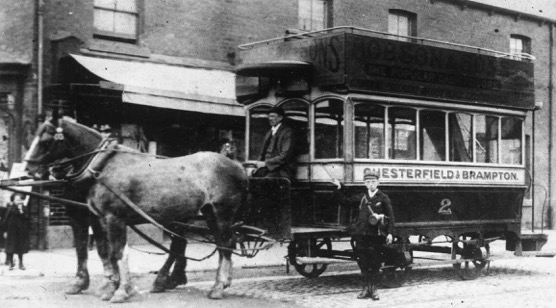
Horsecar No 2 captured at the Walton Lane terminus — photo taken in the early 1900s. With thanks to the National Tramway Museum.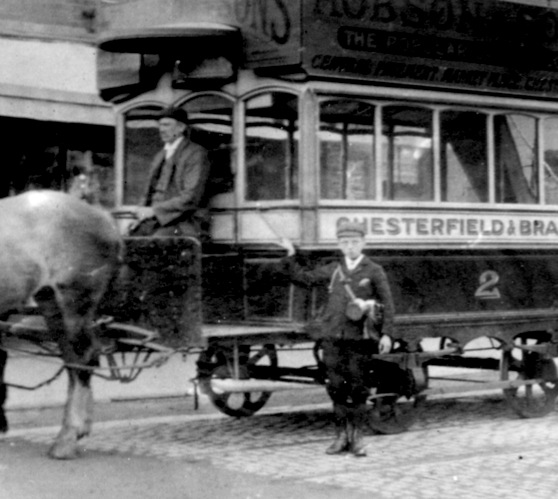
An enlargement of the above photograph showing the driver and a very youthful conductor.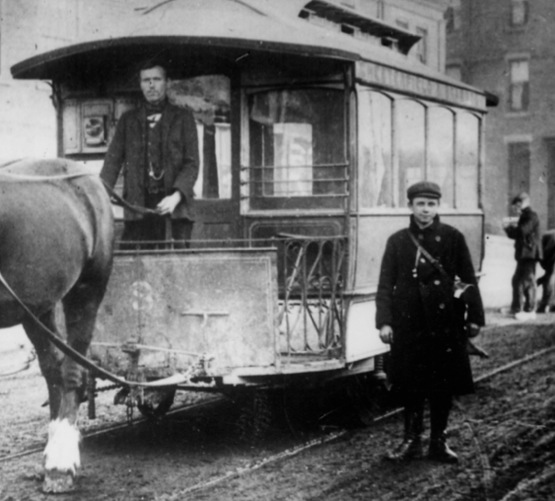
Driver Ezra Coates (later to become a motorman) and his conductor stand with Horsecar No 8 at West Bars — photo undated, but probably taken in the early 1900s given that No 8 was only put into service in 1899. Photo courtesy of the Tramways and Light Railway Society, with thanks to David Voice.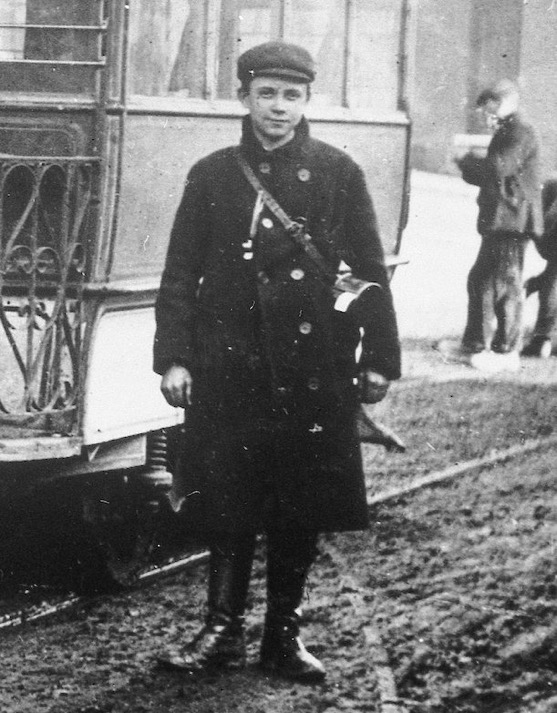
An enlargement of the above photograph showing the young conductor, dressed smartly but informally. With thanks to the National Tramway Museum. 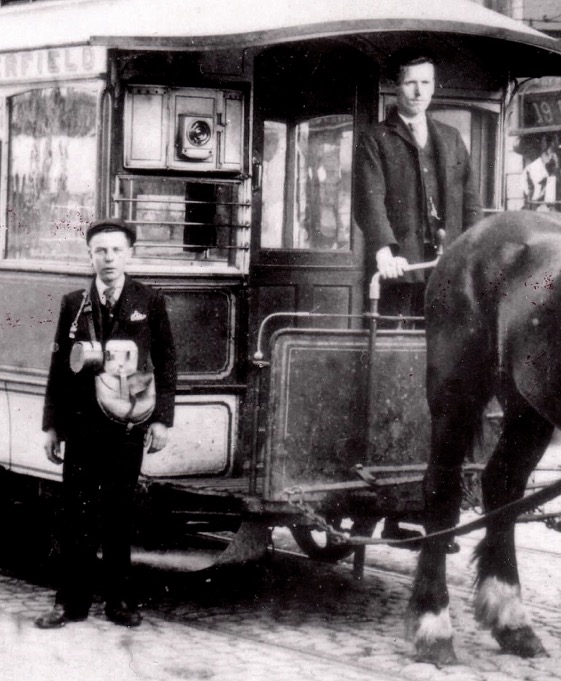
An unknown conductor and Driver Ezra Coates with Horsecar No 8 at St Thomas's loop at the Market Place — photo probably taken during the testing of electric cars on 7th December 1904. Although both men are no longer with us, No 8 most definitely is, and can be seen at the National Tramway Museum in Crich. Photo and background information courtesy of the Barry Marsden Collection.
Motormen and conductors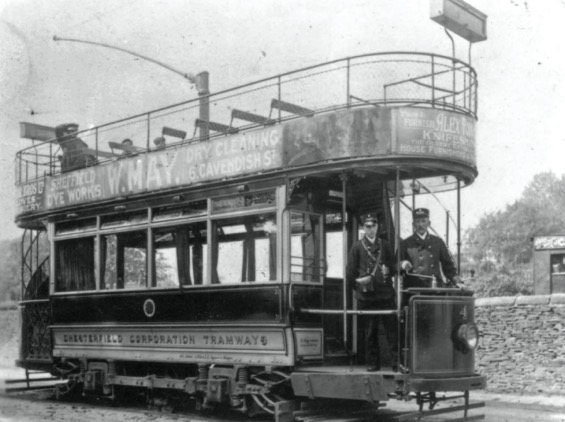
Conductor Derward Lowe and Motorman Cyril Hopkinson pose for the photographer with Tramcar No 4 at Brampton — photo undated, but probably taken not long after the commencement of electric services. Photo and background information courtesy of the Barry Marsden Collection.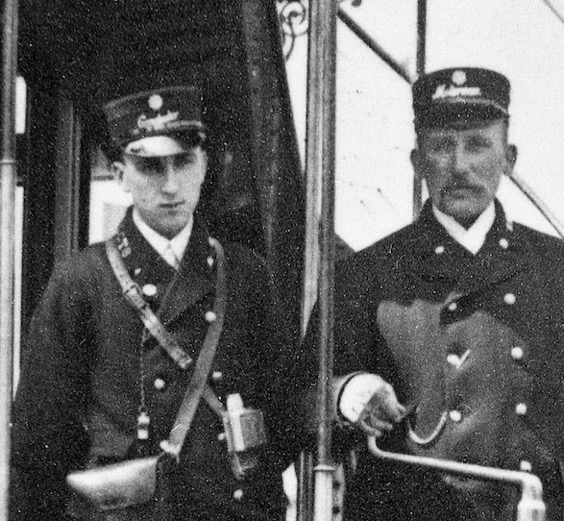
An enlargement of the above photograph showing Conductor Lowe and Motorman Hopkinson, both of whom are wearing drooping-peak caps, script-lettering grade badges and small round cap badges; the latter probably incorporated a municipal device, and appear not to have been a smooth circle, but a more complex shape akin to a rosette. Conductor Lowe's collar insignia appear to be 'C C T' initials followed by an Employee No (possibly '6' or '8').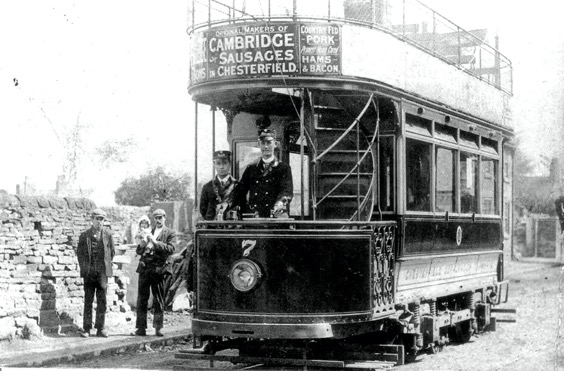
A conductor and a motorman at the controls of what is very probably a brand-new Tramcar No 7 at the Brampton terminus — photo undated, but probably taken in late 1904 or early 1905. Photo courtesy of the Barry Marsden Collection.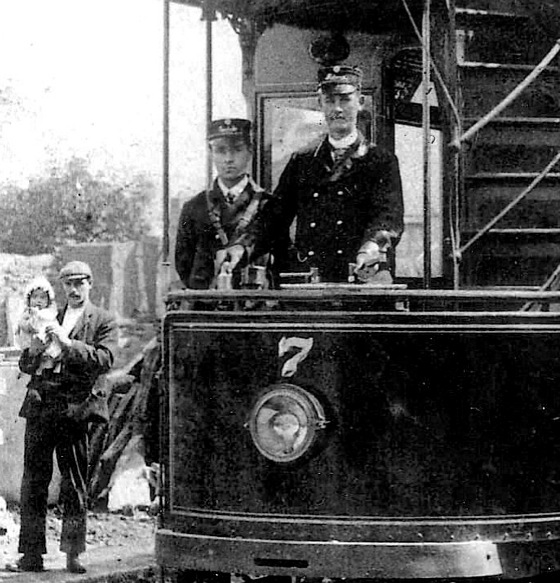
An enlargement of the above photograph showing the crew, both of whom are wearing double-breasted jackets and drooping-peak caps.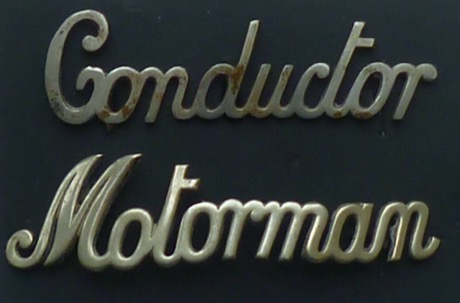
Standard off-the-shelf script-lettering grade badges of the type worn by Chesterfield tramcar crews on their caps — nickel. It is currently unclear which material Chesterfield actually used. Author's Collection.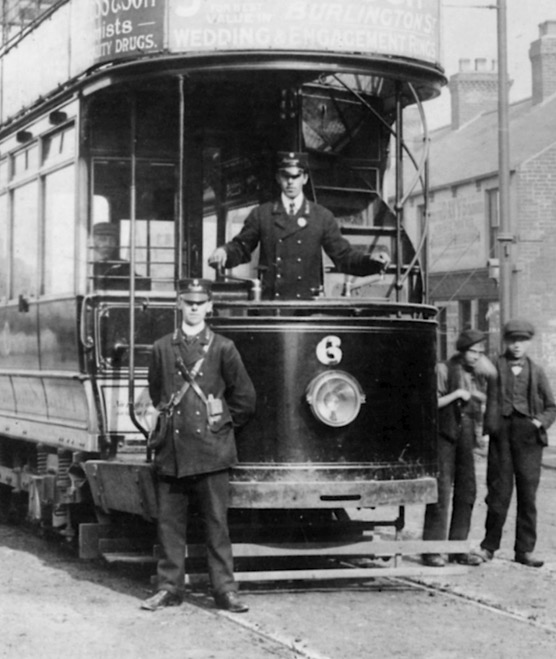
The crew of Tramcar No 6 at the terminus at Whittingham — photo undated, but probably taken not too long after opening. Both men are wearing drooping-peak caps. Photo courtesy of the Tramways and Light Railway Society, with thanks to David Voice.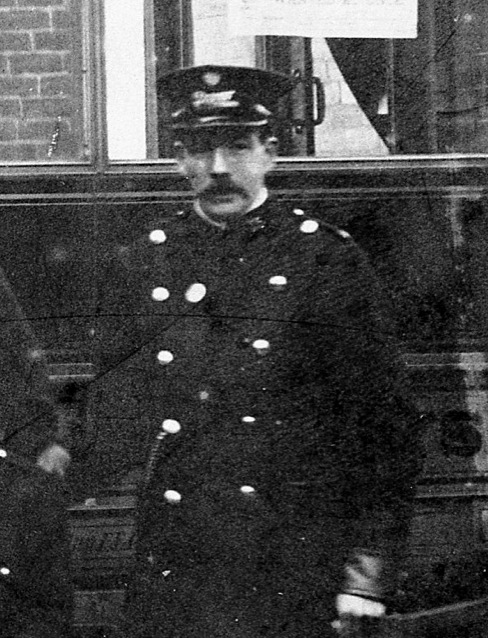
Motorman Harry Longden wearing a script-lettering 'Driver' grade badge on his tensioned-crown peaked cap, along with a round badge (probably municipal) — photo taken in 1917. He also appears to be wearing a badge on his breast, which is probably regimental, a common practice during the Great War.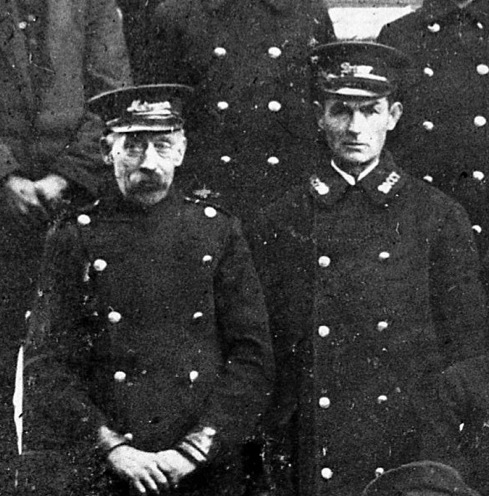
Two Chesterfield motormen, one wearing a 'Motorman' grade badge, and the other a 'Driver' grade badge — photo taken in the Great War (from the staff photo below).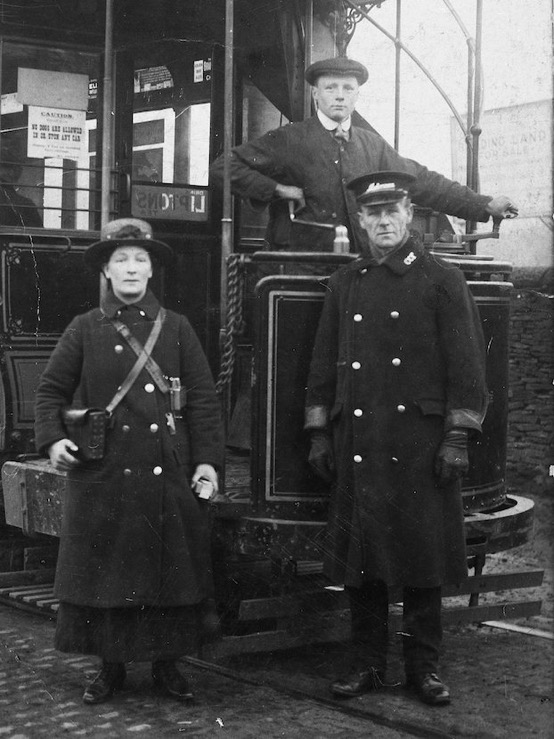
Motorman Thomas Falconer (foreground) with an unknown conductress and a trainee motorman or member of the depot staff (at the controls in civvies) — photo undated, but certainly taken in the Great War or shortly thereafter. With thanks to the National Tramway Museum. 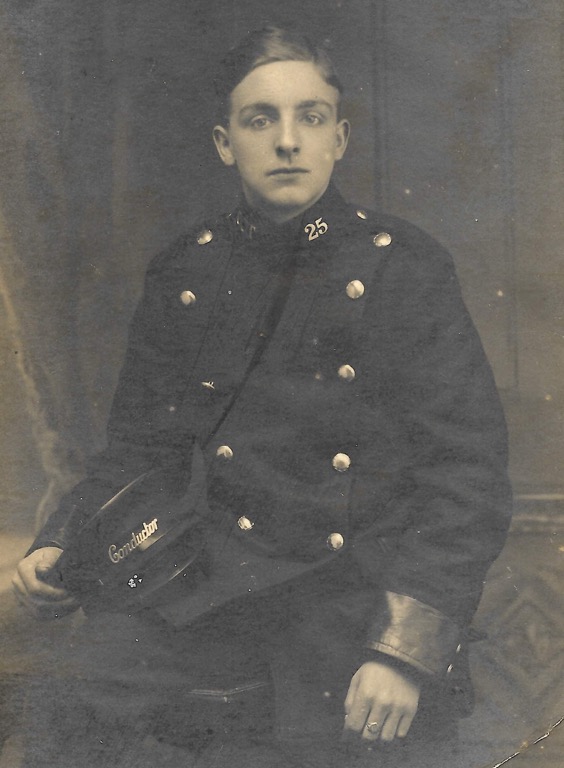
A rare studio portrait of a Chesterfield Corporation Tramways conductor (Employee No 25) — photo undated, but possibly taken in the early 1920s. The quality of the photograph is good enough to discern the plain, scallop-rimmed buttons. Photo courtesy of the Stephen Howarth Collection.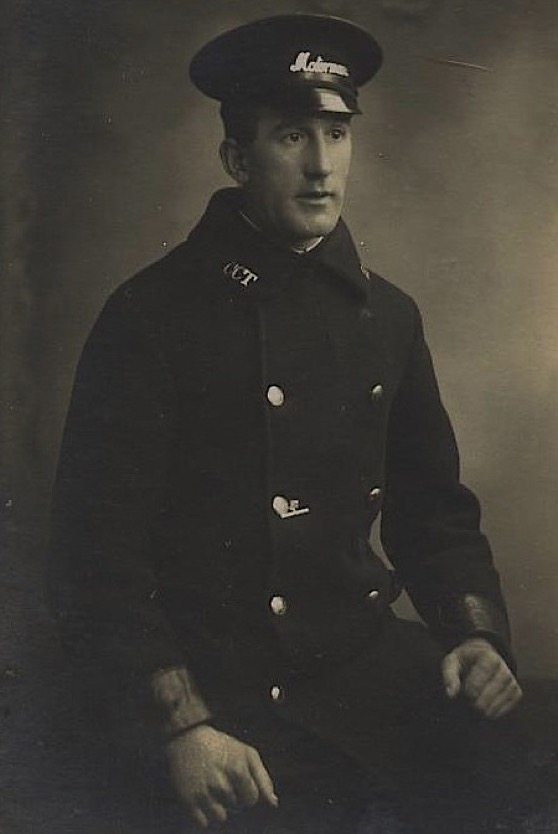
A studio portrait of a Chesterfield motorman — undated, but probably taken in the 1920s. Source unknown.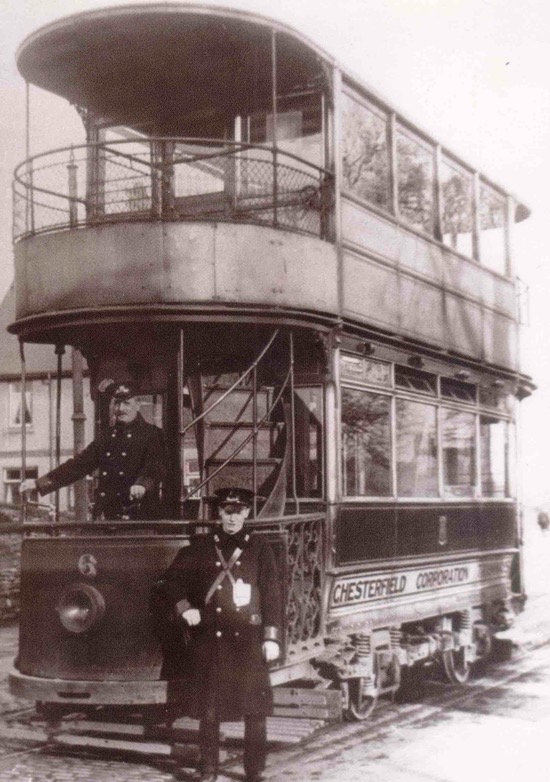
Motorman Jack Rouse and Conductor Gary Gascoyne with Tramcar No 6 at Brampton — photo undated, but probably taken in the 1920s. Photo courtesy of the Barry Marsden Collection.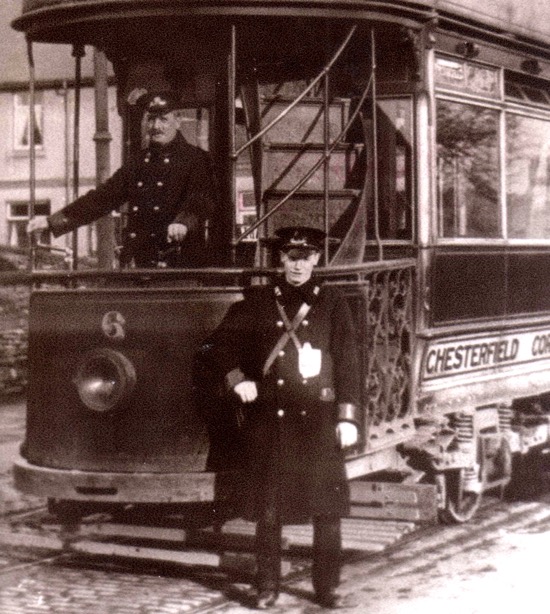
An enlargement of the above photograph showing the tramcar crew, both of whom are wearing long, double-breasted greatcoats. Photo courtesy of the Barry Marsden Collection.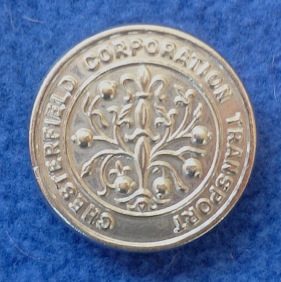
Chesterfield Corporation Transport cap badge — chrome. This type of cap badge was certainly never worn by tramways staff, but may have been based upon one worn by them in the early years of the tramway. Author's Collection.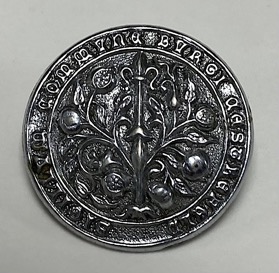
A Chesterfield municipal-device badge — chrome. Although the central design and motto seen here may have been used on the early tramway cap badges, surviving photographs suggest that the latter had rosette-type edging rather than a smooth circumference. With thanks to the National Tramway Museum.
Senior staff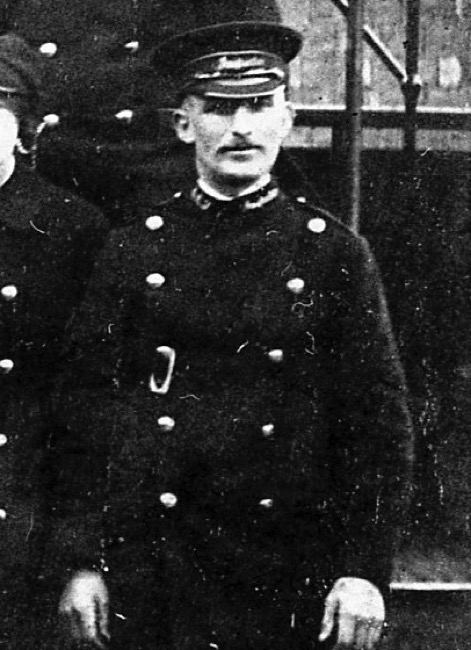
Inspector James 'Jimmy' Blount (from the Great War female staff photo below) — taken in the Great War. He is wearing a script-lettering cap badge, along with embroidered collar designations, Inspector (on his left) and system initials — C C T — on his right. With thanks to the National Tramway Museum. 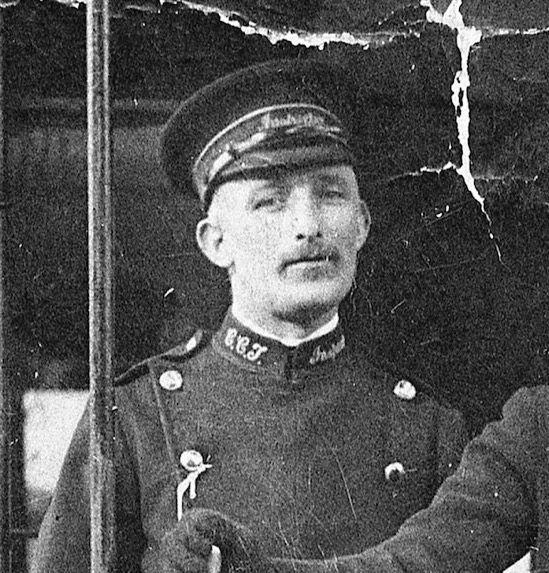
A close-up shot of Inspector 'Jimmy' Blount taken from the photo of Tramcar 18 below. His collar insignia are easily made out. 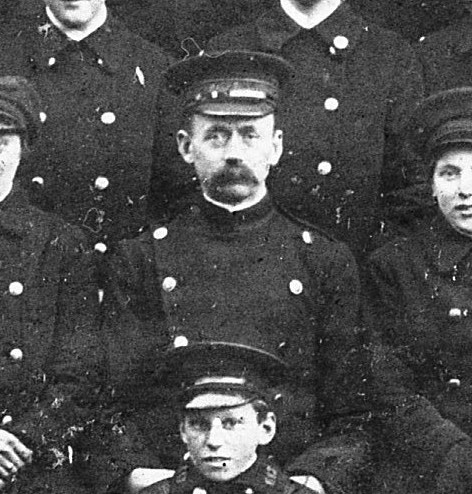
Another enlargement taken from the Great War female staff photo shown below, this time of Chief Inspector Root. Whilst his collars appear to be devoid of insignia, his cap would seem to bear his grade (half hidden by the chin strap), in embroidered script lettering. With thanks to the National Tramway Museum.
Female staff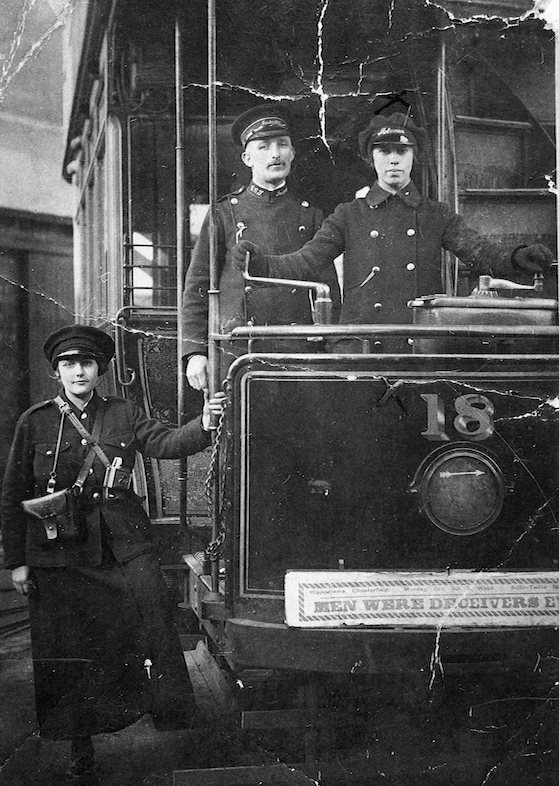
Conductress Kathleen Allen, Inspector Jimmy Blount and Motorwoman Elinor Dowson pose for the camera with Tramcar No 18 in October 1917, neatly dated by the advertisement for the Hippodrome Theatre affixed to the bottom of the dash. With thanks to the National Tramway Museum. 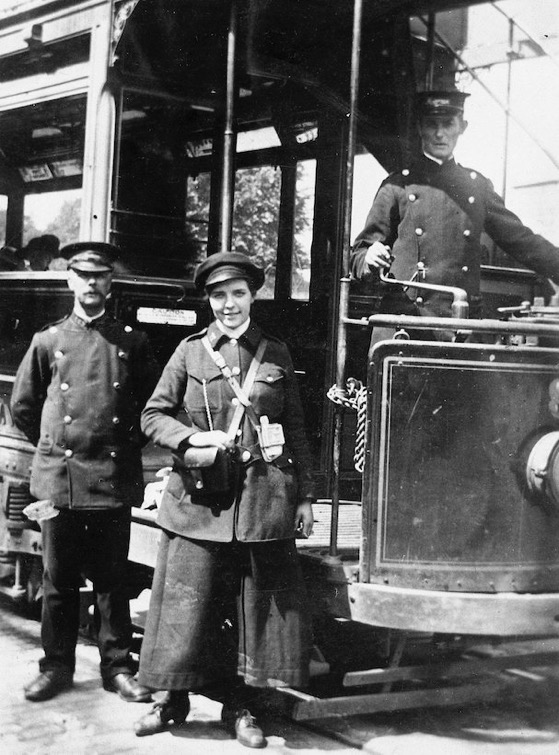
Inspector William Cotterill, Motorman Thomas Falconer and Conductress Elsie Dowson (Elinor's sister), with Tramcar No 9 at Brampton — photo undated, but probably taken in 1917 or 1918. With thanks to the National Tramway Museum.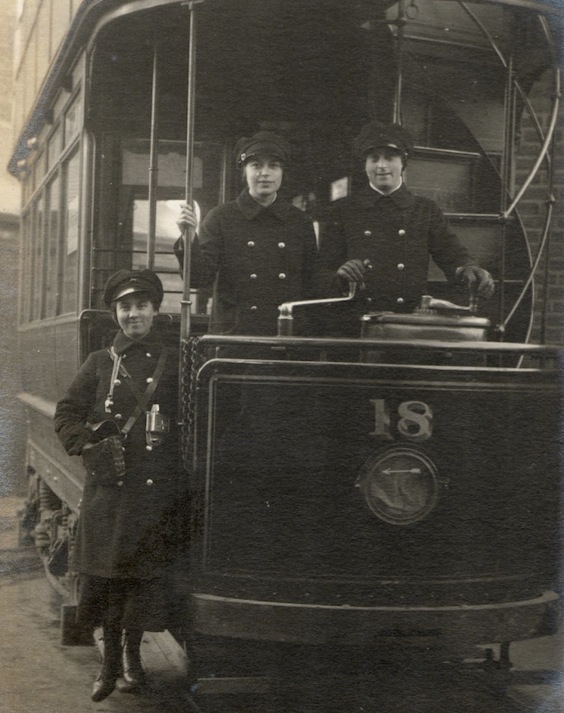
A conductress and two motorwomen pose with Tramcar No 18 for the camera of local photographer William Leuchars — photo undated, but certainly taken during the Great War. Author's Collection.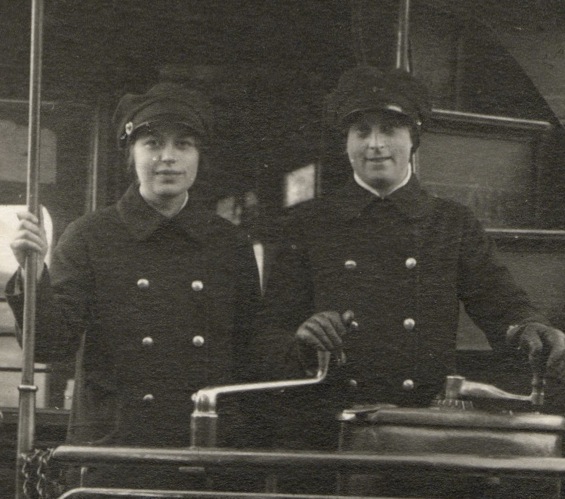
An enlargement of the above photograph showing the two ladies on the platform — the one on the left is believed to be a Miss Mallory (thanks to Barry Marsden for this information). The uniforms are completely devoid of insignia, including cap badges. The shield-shaped badge on the side of Miss Mallory's cap is probably a sweetheart badge.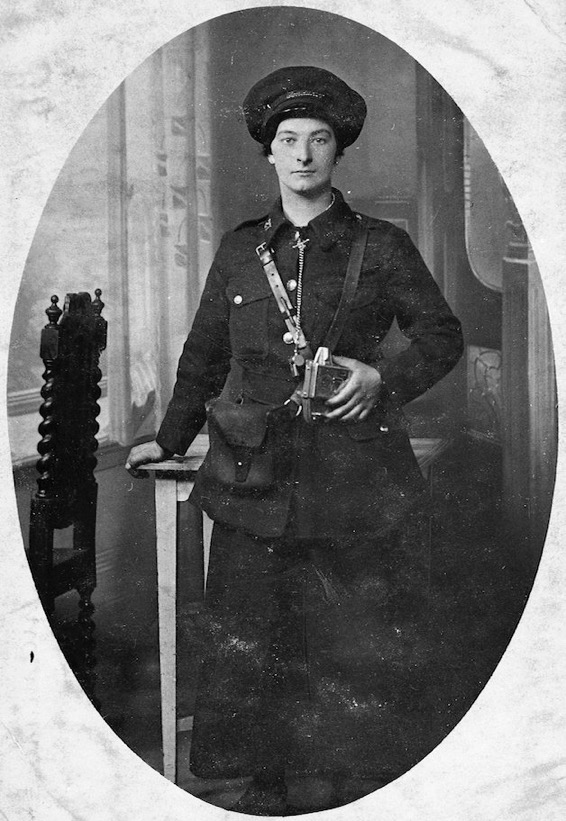
Conductress Amy Trueman — photo undated, but certainly taken during the Great War or shortly thereafter. With thanks to the National Tramway Museum.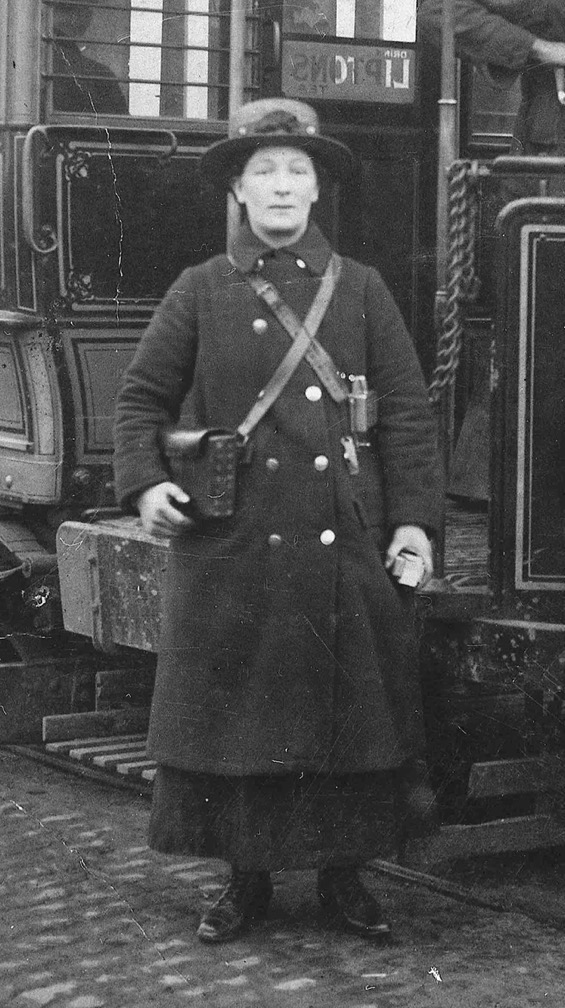
A blow-up of the Great War photo with Motorman Thomas Falconer (see above), showing the conductress. She is wearing a straw bonnet with a cockaded hatband.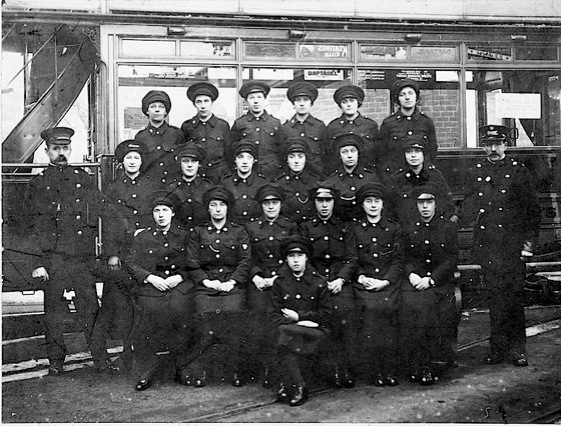
A line-up of female staff taken in 1917. Just two of the ladies are wearing a cap badge, in both cases standard, off-the-shelf, script-lettering grade badges: 'Conductor' and 'Motorman'. Miss Mallory (see photo of Tramcar No 18 above) is standing next to the motorman (Harry Longden) on the middle row, right-hand side, whilst Amy Trueman is seated on the front row, second from the left. The lady at the left-hand side of the middle row is believed to be Sarah Trueman, Amy Trueman's sister. With thanks to the National Tramway Museum.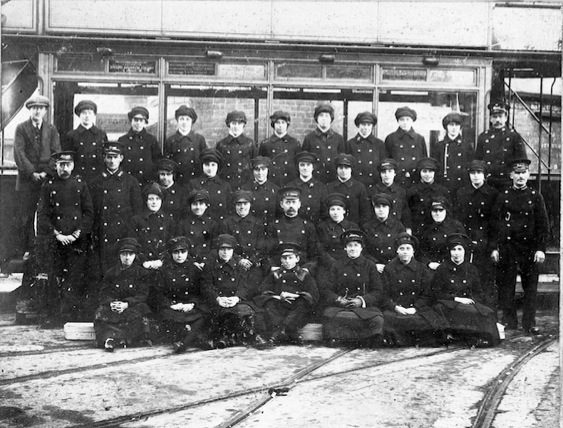
Another Great War staff photo, this time showing the female staff in their greatcoats. Only one lady is wearing a cap badge. With thanks to the National Tramway Museum.